The Sludge That Kills — Post Mortem of an Air Conditioner

This is the story of a happy family that got too hot and sweaty. They’d lived in their house for a while, and everything was fine at first. The central air conditioning system kept them nice and cool. Over the past few years, however—they’re not sure exactly when it started—their ‘Home, Sweet Home’ started turning into their ‘Home, Sweat Home.’
One day, for no apparent reason, the air conditioner couldn’t even keep the air inside their home at the 85° F temperature that they’d gotten (sort of) used to. Mom told everyone to check throughout the house and feel for air flow at the supply registers, but no one felt the faintest whisper of air coming out of them at all. Come to think of it, not a single person in the happy family could remember the last time that they had actually noticed air coming out of the vents.
That was it! Dad marched them all out to the backyard on that hot afternoon to see if the air conditioner was running. Little Cindy thought she’d heard a huge clunking kind of sound — Kwaaaa-klurnp-Kwaaaa-klurnp-Kwaaaa-klurnp, it went — back there earlier in the day, but as they stared blankly at that old metal box, it just sat there, silently soaking up the summer sun, making no pretense that it was doing anything to cool their home. They knew it was finally time to call the air conditioning service company.
The HVAC service company arrives
When the HVAC company’s truck arrived at their house, the repairman quickly discovered that the compressor had failed completely. Then he went inside and looked at the blower and evaporator coil. He went ahead and took the whole thing apart and learned quickly that there was no use in trying to restore their old air conditioner. They needed a new one.
Here’s what he found that probably killed it.
From the top, the evaporator coil didn’t look so bad.

As you can see below, the fins look nice and clean so the air should have been able to move freely through them.
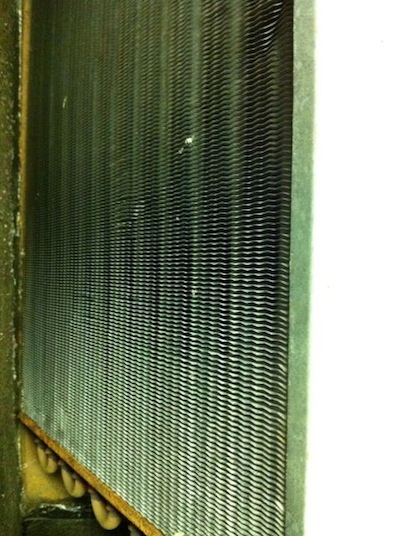
But wait! That was the output side of the evaporator coil. When he turned it over to look at the side where the air went into the evaporator coil fins, he saw this.
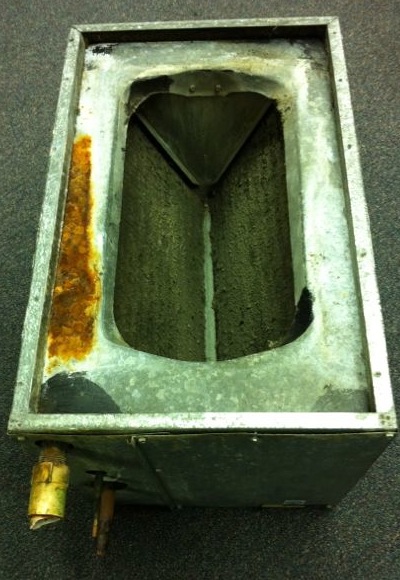
Let’s zoom in a little.
Wow! That is one heck of a lot of sludge!
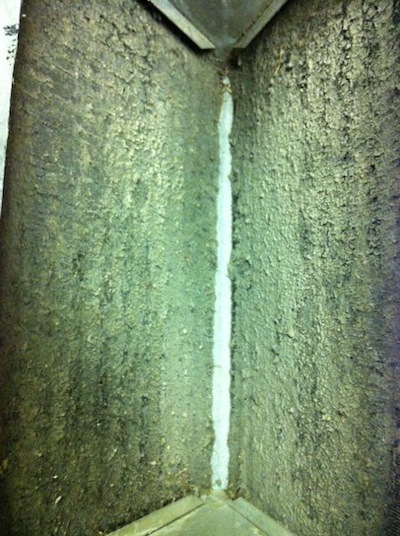
It’s amazing that they lived with this system as long as they did. But it’s not surprising they felt no air coming out of the supply vents.
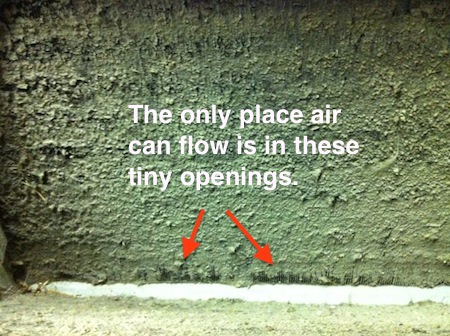
The coil is covered almost 100% with dirt that turned to sludge when it hit the wet coil. Let’s zoom in just a little more for jollies.
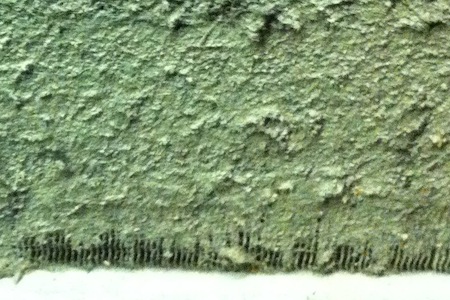
Uh huh. Is it any wonder they felt no air coming out of the vents?
What caused this sludge to build up on the coil?
I made up the story about the happy family above because all I know is that my friend Jake Reid at Moncreif Heating & Air Conditioning gave me this coil from a dead air conditioner that they had replaced. It’s not hard to see, though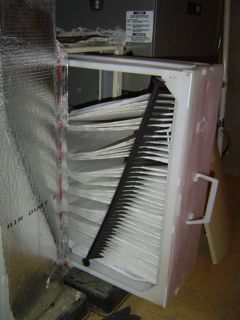 , that this air conditioner wasn’t doing much to keep the house cool. It’s hard to condition air when no air can flow through.
, that this air conditioner wasn’t doing much to keep the house cool. It’s hard to condition air when no air can flow through.
The problem here was that a lot of dirt got through the duct system and the filter. So, how did it get so dirty? Again, I don’t know the actual story behind this one, but one possibility is that the air bypassed the filter. It might do that when a filter doesn’t cover the entire duct, as shown at right. Another possibility would be that there’s a lot of leakage between the filter and the blower, and the system pulls in dirty crawl space or attic air. When you put the filter at the return grille in the house, that could easily happen. Also, the dirtier the filter gets, the more air it’ll pull in through the leakage sites rather than from the house, where it’s supposed to be pulling all its air from.
Don’t let this happen to you!
Here are a few tips to make sure you don’t end up with a coil that looks like the one above.
- Check and change your filter regularly.
- Have your duct system tested for leakage—preferably as part of a home performance assessment or energy audit. Then seal the leaks in your duct system. (Caution: Make sure to include this as part of a complete analysis of the air flow in your duct system and combustion safety of your home. It’s possible to cause problems, possibly even freezing up the coil and burning out the compressor, by sealing ducts.)
- Get your heating and air conditioning system serviced once a year and make sure they check to see how clean the coil is and then clean it if necessary.
There’s no excuse for a coil as dirty as the one I showed you here. Take care of your air conditioner, and it won’t die of asphyxiation like this one did. Let it die a natural death. You know, the kind that results from planned obsolescence. It’s always healthier when you can direct your anger at manufacturers rather than yourself.
Related Articles
It’s Called an Air Conditioner — Not an Air Cooler!
The Magic of Cold, Part 1 – How Your Air Conditioner Works
Photo Friday – HVAC Filter Horrors
How to Choose a Company to Do a Home Energy Audit
Allison A. Bailes III, PhD is a speaker, writer, building science consultant, and the founder of Energy Vanguard in Decatur, Georgia. He has a doctorate in physics and is the author of a bestselling book on building science. He also writes the Energy Vanguard Blog. For more updates, you can subscribe to Energy Vanguard’s weekly newsletter and follow him on LinkedIn.
Photo of happy family by DickSijtsma from flickr.com, used under a Creative Commons license. This is not the actual happy family of the story. In fact, I don’t even know if the family who owned this AC was happy. For all I know, the home may have been occupied by a miserable and lonely team of retired mud wrestlers, which could be another explanation for the state of that coil.
Comments are closed.
This Post Has 12 Comments
Comments are closed.

In addition count on
In addition count on replacing the furnace also. If the coil has restricted airflow that much, chances are the furnace has been cycling on the limit switch and the heat exchanger is cracked.
Well, geothermal is a good
Well, geothermal is a good start lowering costs by 50% + (up to 75%), but insulating attic with R=60 to R=80 is best start and might do the trick of not needing AC for most of the time. Walls too should have R=40. new windows and slight shading – and bingo always cool and in the winter cozy…
We see dirty coils in
We see dirty coils in weatherization, but more commonly we see filters that look like these coils because they haven’t been changed in years. I agree that locating the filter at the return register is not ideal. However, we sometimes recommend filters at the register for elderly, disabled, or clients who otherwise cannot or will not go into the creepy attic or crawl space to change filters.
Good read!
So Talo, having geothermal
So Talo, having geothermal technology keeps the coils clean???
The duct leakage may be the
The duct leakage may be the very thing keeping the system, and the clients, happy, alive, and kicking (especially on the return side, in the case of distribution systems located outside of conditioned space). My personal suggestion is to change the second sentence of the middle bullet point to “Only seal the leakage if the results of the whole house assessment indicate it makes sense to do so, and then have your house re-evaluated for combustion safety.”
We see on almost all of the homes we test, nearly 100% of the available total external static pressure, which the manufacturer planned to be placed against the fan, has been used up by the poor design of the return side. And this despite very low airflow across the coil. This is because nearly every system we test is in the 40-50% range of having the proper amount of grille area (target=2 SF per AC ton), and the FPM across the filter face is too high (target=keep below 250 FPM), and they are using high efficiency filtration in a system designed for 30 day filters (that’s being nice, it was never designed at all) and then not changing them regularly as mentioned.
Sealing up leaks is great when that is the problem. Because of the issues above (just on the return side, I haven’t even started on the supply), we’ve never found a system that could be saved by sealing the leaks. Distribution systems are much happier when they are completelty removed, and taken on a permanent vacation.
If you REALLY want to save
If you REALLY want to save money bring the ductwork into conditioned space. Will make a bigger difference than throwing a ton of insulation in the attic/wall.
@MacFarland: I agree with
@MacFarland: I agree with most of what you said. It’s true that duct sealing can cause more problems than it solves. However, your suggested advice is hardly appropriate.
As you stated, high static (and low airflow) is often the result of an undersized return side. But this usually is the easiest to fix without having to resort to complete duct system replacement.
If client doesn’t want to fix the duct system, then it may be reasonable to refuse to seal the ducts, but that should never be the recommended course of action after a whole house assessment.
@Thomas B wrote:
> locating the filter at the return register is not ideal
Actually, it often is ideal. You just have to make sure the return side is tight. Not hard to do, actually.
@David Butler, <
@David Butler,
I agree sealing the return side and locating filter at the return register can be ideal. In new construction it is not hard to do. In the existing homes, it can be a challenge. In the low-income homes that I work on (with a limited budget), it’s often difficult. It can also be tough in homes with multiple return registers.
Bob: True.
Bob: True. I don’t know the actual story here but it’s likely the furnace had problems, too. Regarding ducts in conditioned space, I’ve written about that here in the blog:
Case Closed: Get Those Air Conditioning Ducts out of the Attic
Tapani Talo: It almost sounds like you didn’t even read the article.
Thomas B: I didn’t mean to give the impression that I don’t like filters at the return grille. I do, for ease of changing them. You just have to make sure that the duct system is designed, installed, and sealed properly.
M. Johnson: Maybe it only works with the R-40 walls and R-60 attic that Tapani mentioned. But you’re right — Tapani’s comment seems completely unrelated to the article. I guess he/she thinks they’re getting some benefit from having the link there, even though they’re not.
M. MacFarland: Thanks for the reminder. I do usually mention the proper air flow when I talk about duct sealing because I’m like you — articles about duct sealing without mention of proper air flow kind of drive me crazy. It all goes together. I’m sure a lot of people who read this blog would love to know how you get all your customers to afford and agree to a complete duct system change-out.
David B.: Thanks for your contributions, again.
M. MacFarland
M. MacFarland: I forgot to mention that I added a caution statement to the article right after the duct sealing advice.
Does the “sludge”
Does the “sludge” look green because it’s avocado flavored, because it’s trying to give the airflow a green light, because long green will be required to fix it, or because one gets LEED points if one’s crud is the same color as Kermit the Frog? Inquiring minds want to know.
Hey hi..
Hey hi.. hahahahahahahhahahahahaha nice work.